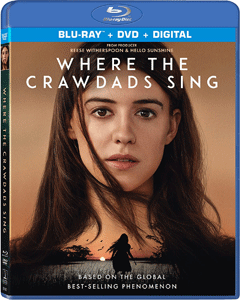I knew from the opening minutes that “Where the Crawdads Sing” would try to manipulate me with its beautiful North Carolina marshlands, music and voiceover narration by sad/pretty Daisy Edgar-Jones. Her character, Kya – derisively called “Marsh Girl” by the townsfolk – is initially adorably played by little Jojo Regina.
We see Kya’s love of the grassy waters (not to be confused with swamps, the narration explains), and more darkly, how her father (Garret Dillahunt, always game for such roles) is a wife- and child-beating terror. I figured I might as well submit and have the Kleenex ready for the film’s end.
“Crawdads” raises a question for critics: Is it good because it successfully does exactly what it telegraphs? Or is it bad because it’s predictable? It depends on the viewer, of course, but … well, I can’t deny that the film made me misty-eyed.
“Where the Crawdads Sing” (2022)
Director: Olivia Newman
Writer: Lucy Alibar, based on the novel by Delia Owens
Stars: Daisy Edgar-Jones, Taylor John Smith, David Strathairn
From the marshes to the courtroom
Writer Lucy Alibar – working from a 2018 novel by Delia Owens – uses a straightforward but effective structure of Kya’s backstory interspersed with her trial for the murder of rich town lad Chase (Harris Dickinson, who looks like a young Val Kilmer).
We learn about Kya’s life in flashbacks – from a cell, she tells it to kindly lawyer Tom (David Strathairn), who comes out of retirement to defend this sweet young woman who everyone thinks is a freak. The “present day” story is a 1969 courtroom drama that makes us hate the justice system (not that that’s the wrong instinct, but Alibar does slather it on). There’s clearly not enough evidence for this to have gone to trial, but society hates Kya for being different.
The casting of Edgar-Jones (having a breakout year along with “Fresh”) makes the movie, and it’s simultaneously the wrong casting. Kya is far too naturally pretty and kind-hearted to be hated by society. Edgar-Jones is never made up to look remotely unappealing; she doesn’t have so much as a sunburn from her mussel-collecting. Kya’s true danger – especially since this is a movie — would be if local bad boys find out this cute little innocent lives alone in the marshes.
Although the casting allows for us to understand Kya’s magnetic draw to both Chase and nice guy Tate (Taylor John Smith, a Scott Porter type), more realism could’ve been gleaned by giving her traits that would inspire scorn. Like maybe she’s pretty, but you can only tell after wiping away layers of grime. (Granted, the school kids do indicate that she smells.) The fact that Kya is illiterate is actually just kind of sad and adorable; it’s clear she’s smart enough to learn once Tate teaches her.
Finding a spark (or Sparks?)
Director Olivia Newman, though, directs “Crawdads” like a Nicholas Sparks film – realistic enough to inspire at least manipulated emotions, false enough to be a little bit magical. It’s shot in Louisiana but set in the N.C. coastal marshes. It captures the beauty of nature while giving us a peek before the age of hotel-lined beaches.
That beauty is an escape from Sixties annoyances such as a government social worker calling a middle-aged black store owner “boy.” I mean “annoyance” both in the sense that such things really did happen, and also because “Crawdads” ain’t exactly subtle (even though young Kya tells her dad “ain’t” isn’t a word – she learned that much from her brief public schooling).
The film’s basic source of pleasure is watching Edgar-Jones be vulnerable and pretty against a vulnerable and pretty backdrop (the developers are coming!). The marketers know this, which is why the poster and Blu-ray cover mainly consist of the actress’ face.
Still, the murder-mystery adds a legitimate extra layer to hold our interest. Although the trial’s existence is absurd, it can’t be denied that Chase is dead, somehow. Alibar and Newman position some clues with eye-rolling bluntness, but they also make subtle use of one key character who I thought for sure would end up being the murderer. Then it turned out I was wrong, but the solution fits … at least thematically.
Plausibility is pushed to its limits here. But because “Crawdads” always has one foot in mists-of-time fantasy, it almost clicks into place. That’s the fictional mystery. As for the film itself, viewers who feel manipulated and viewers who are moved to tears both will have loads of evidence to draw from. A fair judgment of “Where the Crawdads Sing” sits in the murky middle.


